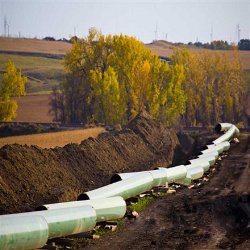No stone is left unturned in the growing search for gas and oil deep within our earth. And as the development of shale spreads across the globe, we’re left trying to feed a new appetite: infrastructure.
 The use of technologies like fracking and horizontal drilling has unlocked a vast amount of shale plays with the power to transform and enrich whole countries at a time. We’ve seen it happen in the U.S. and Canada, and other nations are trying to emulate that. But in doing so, there is a newfound issue with how to get it all to market.
The use of technologies like fracking and horizontal drilling has unlocked a vast amount of shale plays with the power to transform and enrich whole countries at a time. We’ve seen it happen in the U.S. and Canada, and other nations are trying to emulate that. But in doing so, there is a newfound issue with how to get it all to market.
Every phase of oil and gas production must be addressed, from midstream transportation operations – pipeline, rail, barge, and truck – all the way downstream from production sites to oil refineries and raw natural gas processors.
With so much production and not enough infrastructure, we’re left with a bottleneck as transportation capacity is unable to support a growing supply.
U.S. Infrastructure
It all started in the United States, and the problem of infrastructure still persists here. The U.S. continues to break production records each and every day, and while the nation has a much better hold on oil and gas production than other parts of the world, it’s still struggling to deal with its newfound supply.
Infrastructure is the primary reason oil and gas production has stalled in other parts of the world. In the U.S., there have been tremendous strides, but at the end of the day, it’s still not enough.
This is true in some places more than in others. In Pennsylvania, for example, transportation has become a critical issue. For years – even decades – the state has made temporary fixes to its roadways with simple patchwork, but as the oil and gas industry ramps up production, this simply doesn’t cut it.
Pennsylvania needs a long-term sustainable solution to enhance its roadways as it sits in a great global position to feed the marketplace.
Pennsylvania has already quietly invested more than $750 million in road and infrastructure improvements, according to The Patriot-News, but it will take a much larger investment to set the state up for the future, as the region will only increase its shale development.
And I’m not just talking fresh asphalt to repair a few potholes. Pennsylvania-based construction companies will need to hire more workers and use new, improved equipment to make better roadways a reality – that in turn will generate more tax revenue and enhance the oil and gas industry.
While Pennsylvania has made it clear where its problems lie, there have not been significant enough increases in transportation capacity across the country. U.S. refiners, especially those along the coastal U.S., took a hit in the third quarter, according to PR Newswire. Though transportation capacity has increased, it has not been sufficient, and analysts expect that to continue to put pressure on those margins into next year.
Oil and Gas Prices
We have noticed both U.S. and global oil prices going up in recent months. This has much to do with the U.S. creating new infrastructure to remove the bottleneck between the Gulf Coast and Midcontinent. A lot of instability in other parts of the world – the Middle East and North Africa in particular – also contributed.
The mess with Syria and its chemical weapons is just one example, as is escalating instability in places like Iraq, Libya, Egypt, and Yemen. These notable factors have pushed oil up by an average of $5-$10 per barrel in the third quarter, according to PR Newswire.
While oil was moving up, it was natural gas that saw prices moving down. Production continued to increase, especially in the U.S., and even a 16-day government shutdown couldn’t prevent production from going off without a hitch. The U.S. economy was able to flourish in that down time, as well.
Now, strong production from North America is putting pressure on OPEC nations to keep their production in check.
Our analysts have traveled the world over, dedicated to finding the best and most profitable investments in the global energy markets. All you have to do to join our Energy and Capital investment community is sign up for the daily newsletter below.
For the Investor
We should remain leery of oil and gas transactions that are taking place; activity was slow in the last quarter, showing only slight signs of improvement from Q2 to Q3, according to PR Newswire.
In the first nine months of 2013, deals were down almost 10 percent. The year-over-year total deal value was up almost 11 percent, but this was due in large part to Russia conducting large portions of new agreements and not a reflection of global transactions. For the U.S., it was worse – transactions were down in value and volume from 2012.
We should see at least a small rebound in these numbers for 2014. There is a lot of pipeline activity that will open up to new ventures, largely dominated by energy giants that will look for more control of the landscape.
Onshore and offshore activity will improve for next year. New plays will be the target for development, and companies will push the envelope into deeper, more remote, and more complex shale formations. But these developments will likely be slow going at the onset.
When it’s all said and done, everyone will be turning to infrastructure and asking for more – and that’s the next phase for investors.
If you liked this article, you may also enjoy:




